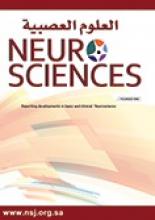Case Presentation
A 12-year-old boy, previously healthy, developed fever and Upper Respiratory Tract Infection symptoms followed by bilateral lower limb weakness, with numbness and right upper limb weakness. He also developed urinary retention. On examination, the reflexes in both lower limbs couldn’t be elicited and there was sensory level up to midthoracic area. His Glasgow coma scale was 15/15. The cerebrospinal fluid analysis showed pleocytosis and high protein. MRI spine is shown below.
Questions
Which of the following is the most probable diagnosis?
Guillain-Barré syndrome
Spinal cord arteriovenous malformation
Acute transverse myelitis
Poliomyelitis
Which of the following is the most commonly affected site of the spinal cord?
Cervical
Lumbar
Thoracic
Cervical and cervicothoracic
Which of the following is first line treatment?
High dose of steroids
Intravenous acyclovir
Intravenous immune globulin
Intravenous antibiotics
Following therapy and during recovery, which of the following is the first to recover?
Sensory impairment
Pain
Bladder function
Motor function
In patients diagnosed with acute transverse myelitis, what’s the risk to develop neuromyelitis optica?
30%
55%
10%
3%
Answers & Discussion
1. c
Acute transverse myelitis is an immune-mediated central nervous system disorder classically described as demyelinating. It can present with back pain as the first symptom followed by motor and sensory deficit or bladder/bowel dysfunction. Sensory symptomatology can be either positive (burning, paresthesia, hyperesthesia, allodynia) or negative (numbness).1,2
2. d
Cervical and cervicothoracic lesions represent the majority of acute transverse myelitis lesions (64%-76%).1,2
3. a
The standard empiric therapy for acute transverse myelitis is high dose corticosteroids. Pediatric patients are usually treated with a 30 mg/Kg/dose (maximum 1000 mg) of methylprednisolone intravenously once a day for 3 to 5 days.1-3
4. b
Following immunotherapy, pain is the first symptom to resolve, followed by an improvement in motor deficits. Bladder function and sensory deficits may take longest to improve.1-3
5. d
The largest cohort study (French & UK collaboration) describing 95 pediatric patients with acute transverse myelitis found that 14% relapsed with multiple sclerosis and 3% with neuromyelitis optica.3
Footnotes
Notice: Authors are encouraged to submit quizzes for possible publication in the Journal. These may be in any field of Clinical Neurosciences, and should approximately follow the format used here. Please address any submissions to the Assistant Editor, Neurosciences Journal, Prince Sultan Military Medical City, PO Box 7897, Riyadh 11159, Kingdom of Saudi Arabia. E-mail: malaskar{at}psmmc.med.sa
- Copyright: © Neurosciences
Neurosciences is an Open Access journal and articles published are distributed under the terms of the Creative Commons Attribution-NonCommercial License (CC BY-NC). Readers may copy, distribute, and display the work for non-commercial purposes with the proper citation of the original work.







